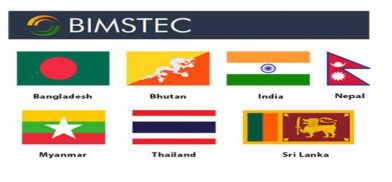India-Bangladesh-Myanmar-Thailand quadrilateral cooperation and connectivity will be hugely beneficial to the region
If the Bangladesh-Myanmar-Thailand-India trilateral highway project and the Bangladesh-China-India-Myanmar (BCIM) corridor were integrated, ASEAN members could access the markets of Bangladesh, northern India, and the Himalayan countries of Bhutan, and Nepal.

Bangladesh is interested in joining the Myanmar-India-Thailand connectivity project. Foreign Secretary Masud Bin Momen said this after the third Foreign Office Consultation took place between Bangladesh and Thailand in Dhaka earlier this month. India and Thailand have agreed to include Bangladesh in the India-Myanmar-Thailand trilateral highway project. Earlier, a Thai delegation led by Sarun Charoensuwan, permanent secretary of Thailand's Ministry of Foreign Affairs, met with a Bangladeshi delegation at the Foreign Ministry to review and explore the bilateral relationship between Thailand and Bangladesh.
Masud Bin Momen said: “Bangladesh wants to join the Myanmar-India-Thailand connectivity project. We have talked with India and Thailand. They have no problem.” “Besides, connectivity can also happen under BIMSTEC. But not only road connectivity, but we also want air and sea connectivity,” he said.
Momen said: “We believe that the current trade of $1 billion will increase to $2 billion in the near future if the goals of our businessmen increase.”
Thailand's Charoensuwan said that Bangladesh was progressing rapidly in economic development. “A business delegation has come with me to discuss trade and investment. We will work with Bangladesh,” he added.
Connectivity is the cornerstone of any regional economic cooperation and integration. The effectiveness of regional networks in facilitating the flow of goods, services, people and knowledge can be defined as regional connectedness. Countries can benefit from regional and sub-regional cooperation through connectivity for sustainable economic development, terrorism prevention, climate change mitigation and poverty reduction. Geographically, Bangladesh has two neighbouring countries, having two seaports. When it comes to leveraging connectivity initiatives in South and Southeast Asia, Bangladesh has huge potential. Trilateral cooperation between Bangladesh and its two neighbours, India and Myanmar, can immediately boost the region’s regional socio-economic and security status.
Will enhance national security and land connectivity
Myanmar is Bangladesh’s next-door neighbour, with which Bangladesh shares a border with India. Myanmar and Bangladesh are almost on the same geopolitical axis, yet trade and other bilateral issues have never been effectively handled. Bangladesh and Myanmar’s relationship has changed of late. The initial lack of convergence between India's and Bangladesh’s energy policies aided China’s successful implementation of a Myanmar-China gas (and oil) pipeline project.
Beyond trade and other collaborations, national security is another aspect of Bangladesh-India relations. Bangladesh shares a 1,879 km of border with India’s northeastern region. India’s northeastern region is home to 475 ethnic groups which makes the region complex from socioeconomic and security perspectives. For improved trade relations between Bangladesh and the Seven-Sister region, according to India's Ministry of External Affairs, a total of 31 projects are at various stages of implementation. India is actively involved in over a dozen projects in Myanmar. Among them, the most prominent are the 160 km-long Tamu-Kalewa-Kalemyo road, the construction of the Rhi-Tiddim road in Myanmar and the Kaladan Multimodal Transport Project.
Bangladesh, India, and Myanmar, the three neighbours, have shared history. India has the ‘Act East’ policy to promote connectivity of the northeastern region with its neighbouring states. Bangladesh is also promoting its ‘Look East’ policy to utilise the geographic advantage of Bangladesh in terms of its location as the gateway between western Asia and eastern Asia. Myanmar has natural resources with solid regional connectivity. However, domestic turmoil, sudden regime change, international sanctions, and the Covid outbreak have slowed the economic growth of Myanmar.
Bangladesh’s 271 km border with Myanmar can play a strategic role as a potential trade corridor between the two countries. However, at present, the area is militarized due to ongoing internal conflicts in Myanmar. Were this to be resolved, Bangladesh could develop routes via Myanmar to access China to the east, the Association of Southeast Asian Nations (ASEAN) countries to the south, and the South Asian Association for Regional Cooperation (SAARC) to the west. With Thailand bordering Myanmar, and were the Rohingya conflict to be resolved, Myanmar and other ASEAN countries could access South Asia through Bangladesh. If the Bangladesh-Myanmar-Thailand-India trilateral highway project and the Bangladesh-China-India-Myanmar (BCIM) corridor were integrated, ASEAN members could access the markets of Bangladesh, northern India, and the Himalayan countries of Bhutan, and Nepal. Improved ties between Bangladesh and Myanmar are therefore very important to boost strategic trade and investment.
Both Bangladesh and Myanmar are members of BIMSTEC, an organization consisting of Bangladesh, Bhutan, India, Myanmar, Nepal, Sri Lanka, and Thailand that seeks to foster regional and economic cooperation. Other ASEAN nations, such as Cambodia, should join BIMSTEC to utilize its benefits
By first promoting trilateral cooperation, the door for opportunities will open for all. The four possible opportunities are highlighted here. Firstly, trilateral cooperation will boost connectivity. The interconnectivity would reduce the cost and time of transporting consignments. According to BIMSTEC’s official website, the BIMSTEC Master Plan for Transport Connectivity is a comprehensive 10-year strategy and action plan (2018–2028) supported by the Asian Development Bank for improving the subregion’s transport linkages, which includes (1) roads and road transport, (2) railways and rail transport, (3) ports and maritime transport, (4) in-land water transport, (5) civil aviation and airport development, (6) multimodal and intermodal transport, (7) trade facilitation, and (8) human habitation.
The Asian Highway, another development project for connectivity, which is being built with funding from the Asian Development Bank, will improve land connectivity between the two countries and improve trade relations. Bangladesh’s Dohazari-Cox’s Bazar railway line is nearing completion. The BCIM is also a proposed network of roads, railways, waterways, and airways that would connect India’s Northeast, Bangladesh, Myanmar, and the Chinese province of Yunnan under an appropriate legal framework.
India-Bangladesh-Myanmar trilateral is also a winner
The BIMSTEC and BCIM promote connectivity, which encourages businesses to invest more in cross-border businesses. The northeastern region is important for India for two reasons. First, is its physical location, and another is its natural resources. India’s northeastern region shares its border with Nepal, Bhutan, China, Myanmar, and Bangladesh. After opening Integrated Check Post in Agartala and Srimantapur between Bangladesh and India’s northeastern region, Moitri Setu will improve trilateral relations in the region. The ICP Sabroom and ICP Agartala will become commercial hubs of international commerce in South and Southeast Asia. A multi-modal connection through Ashuganj in Bangladesh to Tripura and the Sithwe–Kaladan River Project to Lunglei in Mizoram is planned for improved connectivity. It will energise the re-connections of other road networks through Moreh (Manipur) and Ledo (Assam) to Myanmar. This can then further be linked to Thailand and to the road network system in Southeast Asia.
Secondly, from an economic perspective, Bangladesh is a better choice for foreign investment because of its geographical location and political stability. Myanmar has long been noted for its abundance of natural resources. Suvarnabhumi, which means ‘Golden Land’ in Sanskrit, has been associated with Myanmar for over two millennia. Myanmar and Bangladesh signed a border trade agreement in May 1994 to enhance border trading. In September 1995, they established regular border trade between Maungdaw, a town in Myanmar’s Rakhine State, and Teknaf, an upazila in Bangladesh’s Cox’s Bazar district.
At the 5th summit of BIMSTEC, Sri Lanka invited Myanmar and proposed a ‘walk-and-talk’ for the sake of regional connectivity and trade. The revival of old silk corridors within Bangladesh, China, India, and Myanmar is currently a contentious topic. Regional experts predict that the BCIM-EC will cost about $22 billion to build, and its trade potential stands at $132 billion. In 2020, India exported $871 million to Myanmar and imported $742 million from Myanmar. According to the 2020 report, India and Myanmar have agreed to collaborate to introduce India’s RuPay Card in Myanmar as soon as possible and to investigate the construction of a digital payment gateway. On March 15, 2022, Myanmar decided to make the Indian rupee convertible to boost border trade with India.
Thirdly, from a national security perspective, trilateral relations can improve the border security of three countries and the region. The close ties between China and Myanmar are a concern for India. Myanmar shares a border with India’s northeastern states. In November 2021, India became more concerned after the attack on the 46 Assam Rifles by a trans-border extremist group. To contain insurgent groups in the northeastern region and to tighten security to control the Rohingya exodus in India, India follows a dual-track policy with Myanmar.
Bangladesh also participated in the Armed Forces Day parade of Myanmar in 2021. Bangladesh is working to make a platform for a fruitful negotiation with the Myanmar junta for a successful and sustainable Rohingya repatriation. According to strategic analysts, there are about 30 insurgent groups in the northeastern region. Members of these groups reportedly took shelter in the neighbouring countries for which one requires cross-border cooperation. Trilateral cooperation therefore will create collective security for counter-terrorism efforts in the region.
Regional connectivity and cooperation will bring about win-win results in trade, communication, security, energy, tourism, science and technology for Bangladesh, Myanmar and India and beyond.
(The author is an educator-researcher who did her master's in International Relations from the University of Dhaka, Bangladesh. Views are personal. She can be reached at jubedachowdhury103@gmail.com)
I'm not sure if this is a formatting issue or something too do with internet
browser compatibility but I hought I'd post to lett
you know. The design look great though! Hope you get the problem resolved soon. Thanks














Post a Comment